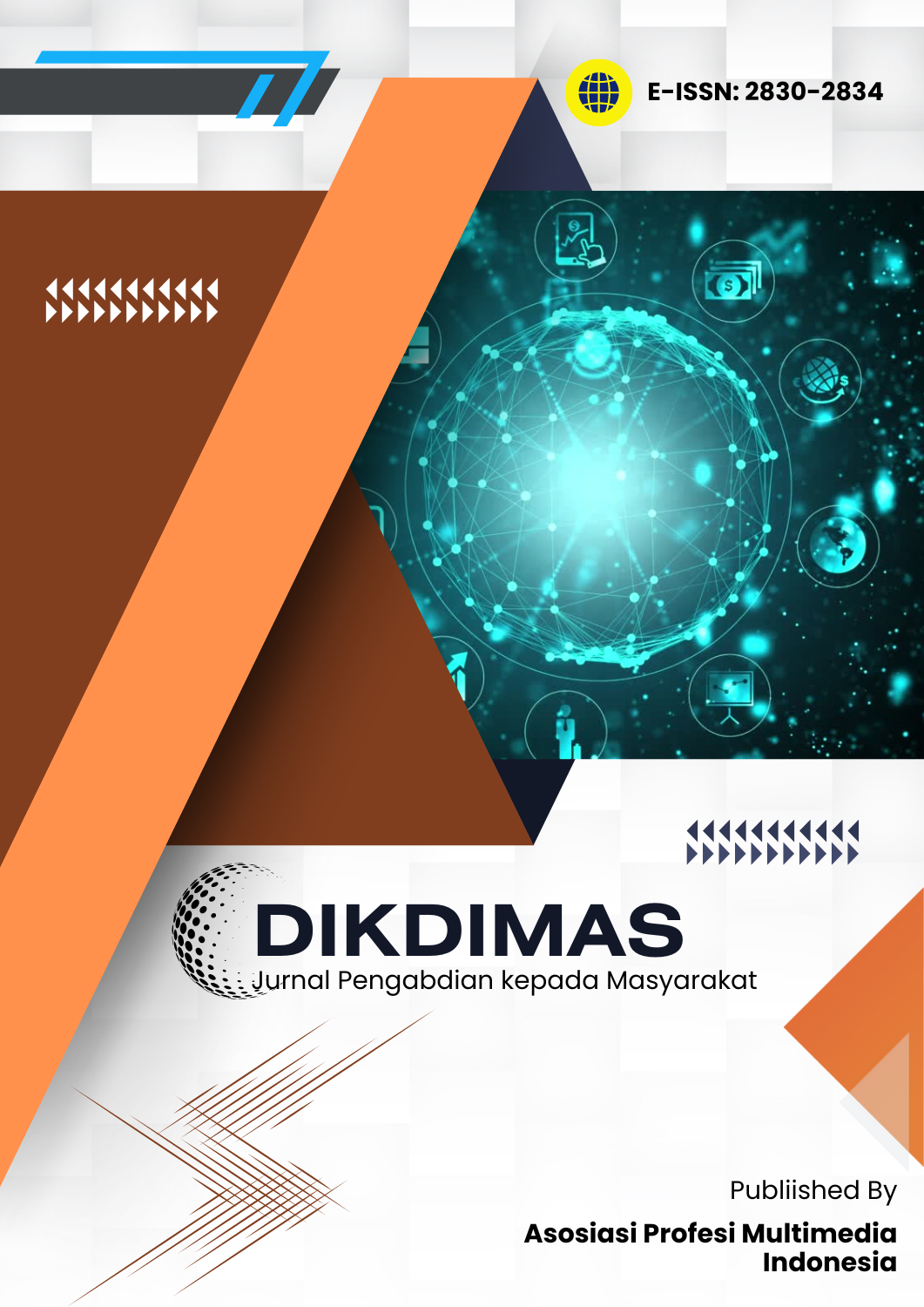Climate Justice Campaign with Theme-Based Learning Approach to Achieve SDGs on Climate Action
Main Article Content
Abstract
Community service activities are a mandatory responsibility for university lecturers as part of the Tri Dharma. This research aimed to investigate attitudes and behaviors towards environmental conservation and analyze the impact of theme-based learning on children in Sei Tuan Village, contributing to broader community-level efforts to protect and preserve the environment. A mixed-methods approach was employed, involving both qualitative and quantitative paradigms to collect and analyze data from 13 children residing in Sei Tuan Village, Deli Serdang Regency. A Pre-Test – Treatment – Post-Test methodology and observations were utilized in conducting the research. The results revealed that 85% of children in Sei Tuan Village demonstrated proficiency in distinguishing between healthy and unhealthy environments. Additionally, all individuals exhibited concern for the environment, including methods of preservation and the benefits of a pristine environment. Notably, 77% of students received comprehensive instruction on categorizing trash into organic, inorganic, and hazardous types. Moreover, 88.5% of individuals articulated positive effects resulting from nurturing environmental affection. Theme-based learning was found to enhance children's recognition of environmental and climate change issues, sparking their interest in learning, particularly in applying basic English vocabulary to care for and protect the environment.
Downloads
Article Details
Copyright (c) 2024 Desri Maria Sumbayak, Erikson Saragih, Indah Putri Tamala, Anggraeni Permata Sihotang, Artha Inanda Silaban, Naomi Sephania Sirait, Muhammad Fikri

This work is licensed under a Creative Commons Attribution-ShareAlike 4.0 International License.
- Authors retain copyright and acknowledge that the Journal of Multidisciplinary Applied Natural Science is the first publisher, licensed under a Creative Commons Attribution License.
- Authors are able to enter into separate, additional contractual arrangements for the non-exclusive distribution of the journal's published version of the work (e.g., post it to an institutional repository or publish it in a book), with an acknowledgment of its initial publication in this journal.
- Authors are permitted and encouraged to post their work online (e.g., in institutional repositories or on their website) prior to and during the submission process, as it can lead to productive exchanges and earlier and greater citation of published work.
References
Arni, A., & Susilawati. (2022). Pencemaran air sungai akibat pembuangan sampah di desa bagan kuala tanjung beringin Kabupaten Serdang Bedagai. Nautical : Jurnal Ilmiah Multidisiplin, 1(4), 241–245. https://doi.org/10.55904/nautical.v1i4.292
Baptise, A. J., Suryanto, Gravitiani, E., & Eric, N. (2021). River Pollution and Human Health Risks : Assessment in The Locality Areas Proximity of Bengawan Solo River, Surakarta, Indonesia. Indonesian Journal of Environmental Management and Sustainability, 5(1), 13–20. https://doi.org/10.26554/ijems.2021.5.1.13-20
Hanif, M., Miah, R., Islam, M., & Marzia, S. (2020). Impact of Kapotaksha river water pollution on human health and environment. Progressive Agriculture, 31(1), 1–9. https://doi.org/10.3329/pa.v31i1.48300
Ibisch, P. L., Hoffmann, M. T., Kreft, S., Pe’er, G., Kati, V., Biber-Freudenberger, L. DellaSala, D. A., Vale, M. M., Hobson, P. R., & Selva, N. (2016). A global map of roadless areas and their conservation status. Science, 354(6381), 1423–1427. https://doi.org/10.1126/science.aaf7166
Kurniasih, I., & Berlin, S. (2015). Ragam Pengembangan Model Pembelajaran untuk Peningkatan Profesional Guru. Kata Pena.
Ma’ruf, A., Novanto, A. E., & Ferdiansyah, F. (2022). Upaya Guru dalam Penanaman Karakter Cinta Lingkungan Berbasis Hidden Curiculum pada Siswa Sekolah Dasar. Journal of Elementary Educational Research, 2(2), 95–110. https://doi.org/10.30984/jeer.v2i2.329
Mackey, A., & Gass, S. M. (2005). Second Language Research: Methodology and Design. Lawrence Erlbaum Associates Inc.
Nakita, C., & Najicha, F. U. (2022). Pengaruh Deforestasi dan Upaya Menjaga Kelestarian Hutan di Indonesia. Ius Civile: Refleksi Penegakan Hukum Dan Keadilan, 6(1), 92–103. https://doi.org/10.35308/jic.v6i1.4656
Pangestu, S. D., Muhdhar, M. H. Al, & Sulisetijono, S. (2023). Analysis of Environmental Literacy Level of Students at MAN 1 Malang City. Bioedukasi, 21(2), 95–98. https://doi.org/10.19184/bioedu.v21i2.39619
Ramadhany, N. (2023). Laju Deforestasi Hutan Akibat Aktivitas Pertambangan di Provinsi Kalimantan Timur. Jurnal Rekayasa Hijau, 7(1), 10–19. https://doi.org/10.26760/jrh.v7i1.10-19
Rijal, M. S., & Amprasto. (2018). Field Trip Method as An Effort to Reveal Student Environmental Literacy on Biodiversity Issue and Context. Journal of Physics: Conference Series, 1013(1), 1–8. https://doi.org/10.1088/1742-6596/1013/1/012020
Rosmaida, E., & Triadi, I. (2024). Pelaksanaan Analisis Mengenai Dampak Lingkungan ( AMDAL ) Di Indonesia Dalam Rangka Penegakan Hukum Lingkungan Hidup. Jurnal Ilmu Pertahanan, Politik Dan Hukum Indonesia, 1(2), 47–65. https://doi.org/10.62951/amandemen.v1i2.133
Sagala, S. (2010). Konsep dan Makna Pembelajaran. Alfabeta.
Salsabila, E. R., Wijaya, A. F. C., & Winarno, N. (2019). Improving Students’ Sustainability Awareness through Argument-driven Inquiry. Journal of Science Learning, 2(2), 58–64. https://doi.org/10.17509/jsl.v2i2.13104
Stevenson, C. E., Heiser, W. J. H., & Resing, W. C. M. (2013). Working memory as a moderator of training and transfer of analogical reasoning in children. Contemporary Educational Psychology, 38, 159–1169. https://doi.org/10.1016/j.cedpsych.2013.02.001
Sugiyono. (2018). Metode Penelitian Manajemen, Pendekatan: Kuantitatif, Kualitatif, Kombinasi, Penelitian Tindakan Kelas, Penelitian Evaluasi. In CV. ALFABETA (Vol. 6).
Wina, S. (2015). Perencanaan Dan Desain Sistem Pembelajaran. Prenadamedia Group.
Zhang, X., Zhang, Y., Shi, P., Bi, Z., Shan, Z., & Ren, L. (2021). The deep challenge of nitrate pollution in river water of China. Science of the Total Environment, 770, 144674. https://doi.org/10.1016/j.scitotenv.2020.144674



 Desri Maria Sumbayak
Desri Maria Sumbayak
